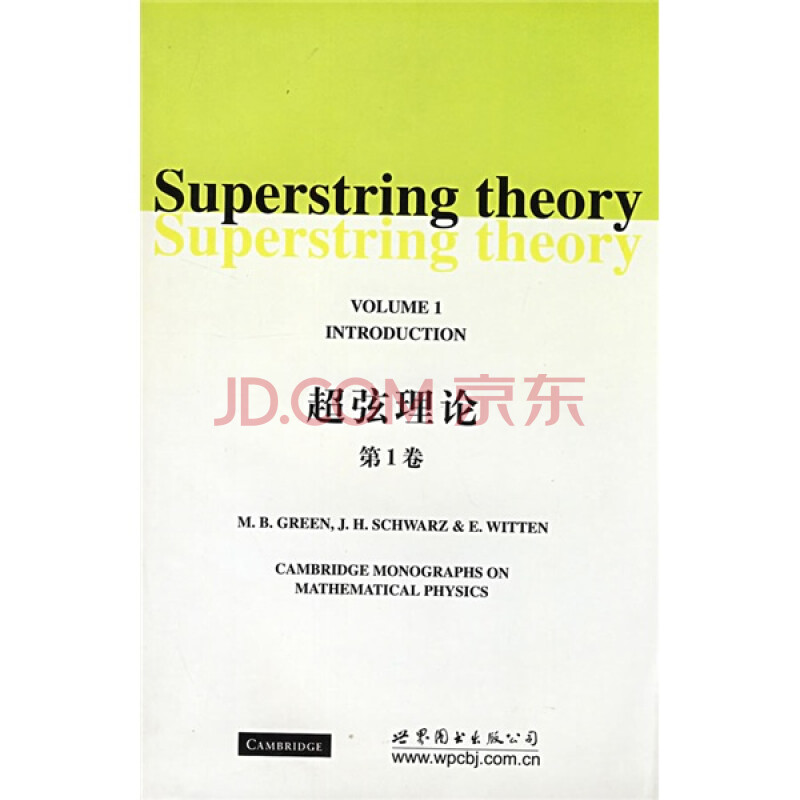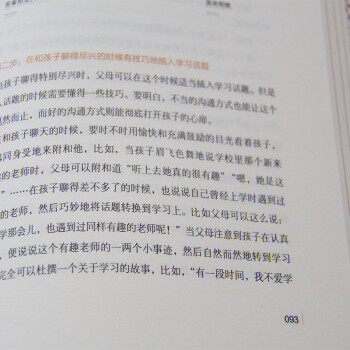热门推荐商品
-
神奇的逻辑思维游戏书 5-13岁提升孩子逻辑思维训练
¥22.50
-
正面管教 修订版 如何不惩罚不娇纵有效管教孩子 育儿百科 最温柔的教养 樊登 早教书
¥19.00
-
一本书读懂中国茶
¥24.90
-
中国国家地理:最好的时光在路上
¥24.90
-
正面管教儿童行为心理学
¥19.00
-
正面管教男孩100招(养育男孩全书)父母的语言话术
¥18.00
-
陪孩子度过7~9岁叛逆期(7-9岁关键养育 叛逆不是孩子的错 男孩女孩自驱型成长)
¥16.30
-
女生呵护指南
¥39.00
-
西尔斯怀孕百科
¥41.50
-
协和医院专家教你吃对不生病:糖尿病吃什么宜忌速查
¥14.90
- 商品名称:超弦理论(第1卷)
- 商品编号:10096463
产品特色
Recent years have brought a revival of work on string theory, which has been a source of fascination since its origins nearly twenty years ago.There seems to be a widely perceived need for a systematic, pedagogical exposition of the present state of knowledge about string theory. We hope that this book will help to meet this need. To give a comprehensive account of such a vast topic as string theory would scarcely be possible,even in two volumes with the length to which these have grown. Indeed,we have had to omit many important subjects, while treating others only sketchily. String field theory is omitted entirely (though the subject of chapter 11 is closely related to light-cone string field theory). Conformal field theory is not developed systematically, though much of the background material needed to understand recent papers on this subject is presented in chapter 3 and elsewhere.内容简介
Recent years have brought a revival of work on string theory, which has been a source of fascination since its origins nearly twenty years ago.There seems to be a widely perceived need for a systematic, pedagogical exposition of the present state of knowledge about string theory. We hope that this book will help to meet this need. To give a comprehensive account of such a vast topic as string theory would scarcely be possible,even in two volumes with the length to which these have grown. Indeed,we have had to omit many important subjects, while treating others only sketchily. String field theory is omitted entirely (though the subject of chapter 11 is closely related to light-cone string field theory). Conformal field theory is not developed systematically, though much of the background material needed to understand recent papers on this subject is presented in chapter 3 and elsewhere.目录
Preface1 Introduction
1.1 The early days of dual models
1.1.1 The Veneziano amplitude and duality
1.1.2 High-energy behavior of the Veneziano model
1.1.3 Ramifications of the Veneziano model
1.2 Dual models of everything
1.2.1 Duality and the graviton
1.2.2 Unification in higher dimensions
1.2.3 Supersymmetry
1.3 String theory
1.3.1 The massless point particle
1.3.2 Generalization to strings
1.3.3 Constraint equations
1.4 String interactions
4.1 Splitting of strings
1.4.2 Vertex operators
1.4.3 Use of vertex operators
1.4.4 Evaluation of the scattering amplitude
1.4.5 The mass of the graviton
1.5 Other aspects of string theory
1.5.1 Gravitational Ward identities
1.5.2 Open strings
1.5.3 Internal symmetries of open strings
1.5.4 Recovery of the Veneziano amplitude
1.5.5 Comparison with QCD
1.5.6 Upitarity and gravity
1.6Conclusion
2 Free bosonic strings
2.1The classical bosonic string
2.1.1 String action and its symmetries
2.1.2 The free string in Minkowski space
2.1.3 Classical covariant gauge fixing and field equations
2.2 Quantization - old covariant approach
2.2.1 Commutation relations and mode expansions
2.2.2 Virasoro algebra and physical states
2.2.3 Vertex operators
2.3 Light-cone gauge quantization
2.3.1 Light-cone gauge and Lorentz algebra
2.3.2 Construction of transverse physical states
2.3.3 The no-ghost theorem and the spectrum-generating algebra
2.3.4 Analysis of the spectrum
2.3.5 Asymptotic formulas for level densities
2.4 Summary
3 Modern covariant quantization
3.1Covariant path-integral quantization
3.1.1 Fazideev-P0pov ghosts
3.1.2 Complex world-sheet tensor calculus
3.1.3 Quantizatlon of the ghosts3.2.1 Construction of BRST charge
3.2.2 Covariant calculation of the Virasoro anomaly
3.2.3 Virasoro, conformal and gravitational anomalies
3.2.4 Bosonization of ghost coordinates
3.3 Global aspects of the string world sheet
3.4 Strings in background fields
3.4.1 Introduction of a background spa~~e-time metric
3.4.2 Weyl invariance
3.4.3 Conformal invariance and the equations of motion
3.4.4 String-theoretic corrections to general relativity
3.4.5 Inclusion of other modes
3.4.6 The dilaton expectation value and the string coupling constant
3.5Summary
4 World-sheet supersymmetry in string theory
4.1 The classical theory
4.1.1 Global world-sheet supersymmetry
4.1.2 Superspace
4.1.3 Constraint equations
4.1.4 Boundary conditions and mode expansions
4.2 Quantization - the old covariant approach
4.2.1 Commutation relations and mode expansions
4.2.2 Super-Virasoro algebra and physical states
4.2.3 Boson-emission vertex operators
4.3 Light-cone gauge quantization
4.3.1 The light-cone gauge
4.3.2 No-ghost theorem and the spectrum-generating algebra
4.3.3 The GSO conditions
4.3.4 Locally supersymmetric form of the action
4.3.5 Superstring action and its symmetries
4.4 Modern covariant quantization
4.4.1 Faddeev-Popov ghosts
4.4.2 BRST symmetry
4.4.3 Covariant computation of the Virasoro anomaly
4.5 Extended world-sheet supersymmetry
4.5.1 The N = 2 theory
4.5.2 The N = 4 theory
4.6Summary
4.A Super Yang-Mills theories
5 Space-time supersymmetry in string theory
5.1 The classical theory
5.1.1 The superparticle
5.1.2 The supersymmetric string action
5.1.3 The local fermionic symmetry
5.1.4 Type I and type II superstrings
5.2 Quantization
5.2.1 Light-cone gauge
5.2.2 Super-Poincar
5.3.2 Closed superstrings
5.4 Remarks concerning covariant quantization
5.5 Summary
5.A Properties of SO(2n) groups
5.B The spin(8) Clifford algebra
6 Nonabelian gauge symmetry
6.1Open strings
6.1.1 The Chan-Paton method
6.1.2 Allowed gauge groups and:representations
6.2 Current algebra on the string world sheet
6.3Heterotic strings
6.3.1 The SO(32) theory
6.3.2 The Es x Es theory
6.4Toroidal compactification
6.4.1 Compactification on a circle
6.4.2 Fermionization
6.4.3 Bosonized description of the heterotic string
6.4.4 Vertex operator representations
6.4.5 Formulas for the cocycles
6.4.6 The full current Mgebra
6.4.7 The Es and spin(32)/Z2 lattices
6.4.8 The heterotic string spectrum
6.5 Summary
6.A Elements of Es
6.B Modular forms
7 Tree amplitudes
7.1 Bosonic open strings
7.1.1 The structure of tree amplitudes
7.1.2 Decoupling of ghosts
7.1.3 Cyclic symmetry
7.1.4 Examples
7.1.5 Tree-level gauge invariance
7.1.6 The twist operator
7.2 Bosonic closed strings
7.2.1 Construction of tree amplitudes
7.2.2 Examples
7.2.3 Relationship to open-string trees
7.3 Superstrings in the RNS formulation
7.3.1 Open-string tree amplitudes in the bosonic sector
7.3.2 The F1 picture
7.3.3 Examples
7.3.4 Tree amplitudes with one fermion line
7.3.5 Fermion-emission vertices
7.4 Superstrings in the supersymmetric formulation
7.4.1 Massless particle vertices
7.4.2 Open-string trees
7.4.3 Closed-string trees
7.4.4 Heterotic-string trees
7.5 Summary
7.A Coherent-state methods and correlation functions
Bibliography
Index


















 沪公网安备 31010402003631号
沪公网安备 31010402003631号